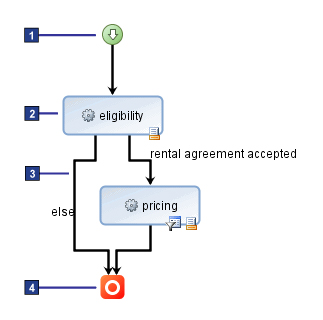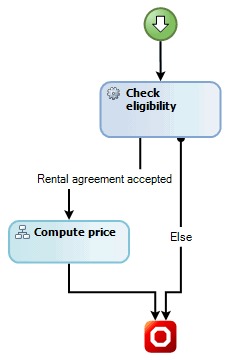Ruleflows
You can use different ruleflow elements to create your ruleflow in a project, such as start and end nodes, tasks, or transitions. A ruleflow specifies how tasks are chained together: how, when, and under what conditions they are executed.
You use ruleset parameters to transfer information between ruleflow tasks, and determine which path to follow through the transitions. For example, you can transfer a status variable, such as isEligible, to determine which task to go to next.
You can also use ruleset parameters to transfer information between the ruleflow and the application. The application obtains the results of ruleflow processing through ruleset parameters. For example, after the ruleflow ends, the parameter can return an aggregated report, diagnostics, a set of compliance exceptions, or computed values, such as prices, rates, or taxes.
The following diagram shows the main parts of a ruleflow:
Start node 1
Task 2
Transition 3
End node 4

Start nodes and end nodes
A start node ![]() and an end node
and an end node ![]() are graphical markers for the start
and end of a ruleflow. Every ruleflow has one start node and at least
one end node.
are graphical markers for the start
and end of a ruleflow. Every ruleflow has one start node and at least
one end node.
Tasks
Between the start node and the end node, the ruleflow is made of tasks linked by transitions.
The tasks of a ruleflow contain the instructions for what to execute and in what order:
- Rule task
A rule task
 contains a set
of rules to be executed at that point in the ruleflow.
contains a set
of rules to be executed at that point in the ruleflow.Depending on how the execution properties of a rule task are set, the rules might execute in order, or following a more complex logic.
The execution mode of a rule task determines whether the rules are executed in the order shown (sequential mode), in order with some optimization at compile time (Fastpath mode), or in an order determined by the rule engine (RetePlus mode).
The runtime rule selection filter determines which rules in a given rule task are executed. The rule selection filter is applied at run time and the rule engine evaluates only the rules that pass through the filter. You write a runtime rule selection filter like a condition in an action rule, except that in the filter statement you can use only rules, rule properties, and any ruleset parameters defined for the rule project.
For example, you can write the following runtime rule selection filter:
the author of 'the rule' is "Sally"
With this filter, the rule engine evaluates only the rules written by Sally.
- Action task
An action task
 contains rule
action statements to be executed. You define the actions of an action
task in the same way that you define the actions for business rules,
by using BAL. Unlike the actions of business rules, however, action
tasks can only use the action phrases associated with ruleset parameters.
You can also define actions in IRL.
contains rule
action statements to be executed. You define the actions of an action
task in the same way that you define the actions for business rules,
by using BAL. Unlike the actions of business rules, however, action
tasks can only use the action phrases associated with ruleset parameters.
You can also define actions in IRL.- Subflow task
A subflow task
 references
another ruleflow to be executed. The referenced ruleflow can be any
other ruleflow in the rule project. You can self-reference a ruleflow,
but be careful to avoid infinite loops.
references
another ruleflow to be executed. The referenced ruleflow can be any
other ruleflow in the rule project. You can self-reference a ruleflow,
but be careful to avoid infinite loops.You can specify initial and final actions on subflow tasks.
Transitions
Transitions connect tasks in a ruleflow and define the sequence of the ruleflow from one task to another. Transitions are unidirectional and can have associated conditions.
Transition conditions determine whether a transition is part of the execution flow. You define these conditions in the same way as conditions in an action rule.
For example, with the following condition on the transition between the eligibility and pricing rule tasks, the pricing rule task can be performed only when the customer’s rental agreement is accepted, otherwise the ruleflow ends.

A single transition from one task to another does not require a condition. However, when several transitions originate from a task, you use transition conditions to define under what conditions a specific path is followed in the ruleflow.
An Else transition specifies the path to take when a condition is not met. A task can be followed by several transitions but only one of them can be an Else transition. This means that all transitions except the Else transition must have conditions.
Whenever multiple transitions come from a choice, the transitions must have Boolean conditions that specify which path to choose during execution. The last remaining empty transition is automatically computed as an Else transition.
Branches
A
branch ![]() is a node that organizes
conditional transitions. For example, a branch for the age of a customer
organizes transitions with conditions on a given age range. Several
transitions can go to and from a branch. Like transitions created
from a task, all transitions created from a branch must have a condition,
except the Else transition.
is a node that organizes
conditional transitions. For example, a branch for the age of a customer
organizes transitions with conditions on a given age range. Several
transitions can go to and from a branch. Like transitions created
from a task, all transitions created from a branch must have a condition,
except the Else transition.
Forks and joins
A fork ![]() is a node that splits the execution flow
into several parallel paths. The transitions created from a fork do
not have conditions because all transitions created from the fork
are followed.
is a node that splits the execution flow
into several parallel paths. The transitions created from a fork do
not have conditions because all transitions created from the fork
are followed.
A join ![]() is a node that combines all the transitions
created from a fork when the parallel paths are all completed.
is a node that combines all the transitions
created from a fork when the parallel paths are all completed.
Initial and final actions
You can define initial actions and final actions on tasks. Initial actions apply before a task is processed and final actions apply after a task is processed. You define initial and final actions in the same way as you define actions for an action task.
A task execution sequence consists of executing its initial actions, then its body, and then its final actions.
Initial and final actions are not mandatory and you can use them independently of each other.
You can also specify actions to be executed at the start and end nodes. For example, you can define an action on the start node to reset the data used in the ruleflow. Actions defined for an end node also apply to any other end nodes in the ruleflow.